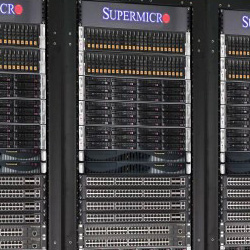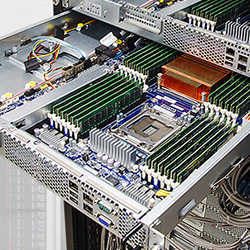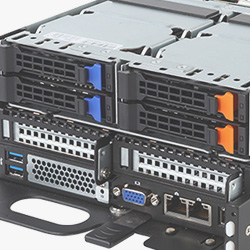Rack Scale Design



Gigabyte - Open Compute Project

Supermicro Rack Scale Design (RSD)
Supermicro RSD, a rack-scale total solution, empowers cloud service providers, telecoms, and Fortune 500 companies to build their own agile, efficient, software-defined data centers. Built on industry-standard, RESTful Redfish APIs from Distributed Management Task Force (DMTF) and open-source Intel® Rack Scale Design software framework, Supermicro RSD integrated rack solution can be flexibly configured using Supermicro's broad and optimized server, storage and switch hardware products. Supermicro RSD total solution accelerates large scale data center deployments by elevating provisioning and management to the rack level and maximizes resource utilization through disaggregating compute, network and storage resources distributed within a rack or across multiple racks.

Key benefits of Supermicro RSD:
- • Open RESTful API based rack-level management provides interoperability and scalability in cloud-scale infrastructure without vendor lock-in
- • Disaggregated hardware and dynamic composability maximize utilization of compute, network and storage resources while meeting ever changing workloads
- • Future-proof investment with existing and new disaggregated hardware. Pick and choose the best hardware building blocks to configure the racks that meet your specific workloads
Supermicro RSD Software Components
Supermicro RSD includes the following software components:
- • Pod Manager (PodM): A pod is a collection of physical racks. Pod Manager sits at the top of the logical software hierarchy and uses Redfish APIs to communicate with the racks that make up the pod. It manages and aggregates the hardware resources within multiple racks in the Pod by communicating with respective PSMEs and RMMs.
- • Rack Management Module (RMM): RMM manages power and thermal resources within a rack by polling rack hardware and reports this information to PodM through Redfish APIs.
- • Pooled System Management Engine (PSME): PSME acts as the drawer or chassis manager. PSME communicates with each BMC controller in the drawer/chassis and reports aggregated information such as telemetry and asset information through Redfish APIs to PodM.
- • Pooled NVMe Controller (PNC): For the new pooled NVMe storage, the PSME equivalent is called PNC.
- • Web UI: A browser-based graphical user interface that simplifies the management of RSD.
To streamline Supermicro RSD deployments, all required management software components are packaged into a 1U management appliance with each software component running in its own container.
Supermicro RSD Hardware Requirements
Since Supermicro RSD runs on all X11-generation server and storage systems supporting Intel® Xeon® Scalable processors, and networking hardware, customers have the total flexibility to build optimized Supermicro RSD racks that best serve their needs.
A minimum Supermicro RSD rack includes the following hardware components:
- • A 1U management appliance and all RSD related software. The ordering SKU is SYS-5019S-TN4-SRSMGT and SFT-SMCI-SRSDM for the RSD software. A second management appliance can be ordered as a standby for high-availability applications
- • One Supermicro 1Gb Ethernet management switch for connecting the BMC controllers
- • One Supermicro data switch, such as SSE-X3348TR (10GbE) or SSE-C3632SR (100GbE)
- • Select your compute nodes from Supermicro's X11-generation server portfolio based on Intel® Xeon® Scalable processors. Popular server choices include, but are not limited to TwinPro™, BigTwin™, FatTwin™, Ultra, and MicroBlade™.
- • Select your storage nodes from Supermicro's storage portfolio. Popular choices include the 32 NVMe SSDs in 1U disaggregated storage (SSG-136R-N32JBF), 2U Ultra with 24 NVMe as hot storage, 2U SSG with 24 SAS HDDs as warm storage and 60-bay or 90-bay JBODs as cold Storage.
Supermicro RSD 2.1 Key Features
The most exciting breakthrough in the latest Supermicro RSD total solution is the high-performance, high-density, and disaggregated NVMe storage. Based on Intel RSD spec 2.1, the arrival of this innovative technology marks the beginning of a paradigm shift to deploy truly disaggregated resource pools in today’s large scale data centers that will dramatically improve data center efficiency, increase utilization and reduce costs.
At just 1U rack space, Supermicro disaggregated NVMe storage supports 32 hot-swap 2.5" NVMe SSDs or the new Intel "Ruler" form factor and up to 1PB of NVMe storage capacity. With an innovative and elegant pull-out tray design for hot-swap and tool-less drive carriers, deploying and servicing the disaggregated NVMe storage in a Supermicro RSD deployment is extremely easy.

Other key features in Supermicro RSD 2.1 include:
An interactive dashboard that provides the data center administrators an overview of all physical assets under RSD management
An interactive, topological view of the physical rack and chassis in the Supermicro Pod Manager UI. Administrators can further select chassis in the rack to drill down on details at the component level such as BMC IP address, physical position in the rack, and so on


URL: https://www.supermicro.com/solutions/SRSD.cfm
GIGABYTE GSM-RSD

Physical Layers and Software Architecture
Hardware: Intel® RSD adds the ability to dynamically compose physical hardware resources into the most optimal configuration for each workload. This ability to “compose on the fly” frees data center managers from re-partitioning hardware manually. When compute, storage, and network resources are under-utilized, they can be re-allocated with ease.
Software: Intel® RSD is built on an open RESTful API standard that is gaining wide adoption in the industry. By using an open standard, end users are not “locked in” to a proprietary vendor’s solution. Using the open-sourced Intel® RSD reference software provides additional innovation and differentiation beyond the API standard.
In summary, Intel® RSD unlocks resources from physical servers, creates virtual pools of resources, applies resources to application workloads, composes resources and reconfigures as requirements change.
GIGABYTE GSM-RSD
After careful research and development into Intel’s RSD architecture, GIGABYTE has combined and integrated Intel’s RSD together with GIGABYTE’s Server Management (GSM) proprietary software into our products to realize software-defined data centers. We can provide complete GSM-RSD racks incorporating optimized rack servers, Racklution nodes and storage drawers, maximizing resource utilization by disaggregating compute, storage and networking, distributed within a rack or across multiple racks.

https://b2b.gigabyte.com/FileUpload/Global/MicroSite/354/GSM-RSD.html
Gigabyte - Open Compute Project

What is the Open Compute Project?
The Open Compute Project (OCP) is an initiative that has been launched in 2011 by Facebook with the purpose to design and share innovative specifications for better datacenters. You can find more details on the OCP official website.
Part of this initiative has been a set of standards released by the members of the OCP, called the Open Rack Standards, that contain design guidelines and specifications in order to create more efficient, flexible, and scalable datacenter hardware.

What is RACKLUTION-OP?
RACKLUTION-OP is the name for GIGABYTE’s server product line based on the Open Compute Project’s Open Rack Standards.
GIGABYTE has released two versions of RACKLUTION-OP products – Version 1.0 and Version 2.0, that correspond with Version 1.0 or Version 2.0 of the Open Rack Standards. The most important change for RACKLUTION-OP from Version 1.0 to Version 2.0 has been the change from a triple bus-bar power distribution system (Version 1.0) to a single bus-bar system (Version 2.0). Both systems will continue to co-exist with each other, and customers can choose the design version based on their preference and requirements.
Our Available Racklution-OP Configurations
|
Model |
RACKLUTION-OP |
Bus-bar |
Power Bank |
LAN Switch Space |
Server Room |
Dimension |
|
DO20-ST0 |
Version 1.0 |
3 |
1 / 14.4kW |
2OU |
20OU + 20OU |
2210 x 600 x 1067mm |
|
DO20-ST1 |
Version 1.0 |
3 |
2 / 28.8kW |
3OU |
8OU + 18OU + 10OU |
2210 x 600 x 1067mm |
|
DO60-MR0 |
Version 1.0 |
3 |
1 / 14.4kW |
1OU |
10OU |
665 x 600 x 1067mm |
|
DO21-ST0 |
Version 2.0 |
1 |
1 / 14.4kW |
2OU |
18OU + 20OU |
2210 x 600 x 1067mm |
|
DO21-ST1 |
Version 2.0 |
1 |
2 / 28.8kW |
3OU |
18OU + 18OU |
2210 x 600 x 1067mm |
What are the Advantages of RACKLUTION-OP?
A Modular Design
Unlike the traditional approach where each system fitted into the rack is a full featured server, with GIGABYTE RACKLUTION-OP the redundant functions between all the different rack-mount systems are removed and consolidated into the rack itself. This leaves primary rack-mounts that serve a main function only, such as pure computing, storage, or computing/storage hybrids, and support modules providing the previously redundant functions. Those support modules are all located at the rear of the rack.
Excellence in Power Efficiency
Thanks to the consolidation of the rack power supply module that is cooled and managed more efficiently than individual power supplies integrated into each rack-mount, the total energy consumption of RACKLUTION-OP is significantly lower than a traditional rack. The table below shows the average power savings realized with GIGABYTE RACKLUTION-OP compared to a comparable traditional rack fitted with 1U rack-mounts, both equipped with Intel Xeon E5-2600 processors:

Achieved through a real-time on-demand power delivery adjusted to each individual rack-mount, these power savings numbers make particular sense in many cloud applications where the resource demand fluctuations seldom lead to loadings above 50%. Yet in case of peak demands, GIGABYTE RACKLUTION-OP is still capable of delivering significant energy savings of nearly 10% compared to traditional racks.
High Node Density
As mentioned above, all the power supply, cooling, switching and monitoring devices disappear from the rack-mounts, and in this way their capacity can be fully available to accommodate hardware serving their primary function. The space efficiency is therefore greatly increased within the nodes, without decreasing their actual dimension compared to traditional racks.
Scalability
With its fully modular design, GIGABYTE RACKLUTION-OP is also ready for the growth and evolution of the datacenter. Each module is available individually and can be ordered later in time to add capacity to existing infrastructure. With such flexibility, our customers can setup a configuration matching the current needs of their applications, and as time passes they are able to complete, scale and upgrade their data center as the demand for their service develops.
Easy Assembly & Handling
Once again, it is thanks to its modular design that GIGABYTE RACKLUTION-OP can be easily assembled and handled. All the modules can be handled by a single operator, without the help of elevating tools usually required for 2U or thicker rack-mounts. Moreover, each module is designed with as few screws as possible, and all of them are easily swappable for the smoothest daily handling possible.
URL: https://b2b.gigabyte.com/FileUpload/Global/MicroSite/354/RACKLUTION-OP.html
Meeting the Challenges of Data Center Digital Transformation
Intel® Rack Scale Design is the industry-aligned architecture that fundamentally changes how a data center is built, managed, and expanded over time
Data Is Exploding—Is Your Data Center Ready?
Experts predict that there will be 50 billion connected devices by the year 2020, 1 all generating huge amounts of data. Yesterday’s data center is not going to be able to keep up. The Internet of Things, big data analytics, and machine learning are driving an annual increase of 30 to 40 percent in compute power and data storage capacity.2 T raditional procurement, provisioning, and management methods are inadequate for today’s hyperscale data center. IT teams need a digital transformation solution that meets the capacity demand, reduces cost, and simplifies data center management.

Future-Proofing the Data Center with Intel® Rack Scale Design
The traditional data center houses hundreds or thousands of server racks; each server has its own processors, memory, storage, and other resources. When one of those servers breaks down or needs upgrading, the entire server is usually replaced, even though many of the components, such as storage, interconnects or cooling fans, are still perfectly good. This approach is wasteful and expensive.
Intel® Rack Scale Design (Intel® RSD) is an architecture, aligned to industry-standards, that enables IT to buy only what they need, when they need it. Intel RSD divides the traditional homogenous server into different resource sections within the rack. Available compute, storage, and accelerator resources are attached to a high-speed interconnect fabric, enabling users to compose an optimal system in seconds. By transforming the way a data center is built, managed, and expanded, Intel RSD enables the data center to be more economical, flexible, simpler to manage, and easier to scale out on demand. It also sets the stage for advanced analytics-based data center optimization solutions. And because Intel RSD is aligned with industry standards, you get increased vendor choice and built-in future-proofing.

Reap the Benefits of Disaggregation
Intel RSD provides APIs that enable dynamic composition of resources to meet specific workload requirements. Data center managers can purchase a mix of hardware modules to match current needs, and adjust them as workload characteristics evolve, reducing the need for overprovisioning in anticipation of workload changes. This increases resource utilization and reduces the cost per unit of capacity.
Disaggregation also makes refreshing equipment more economical. Consider a standard 3U server chassis with 14 blades. Refreshing that chassis by replacing all the blades but keeping the chassis itself along with the networking switch, power supply, and fan modules, saves 17 percent over a full-acquisition refresh. But with fully disaggregated servers, you can refresh only the CPU and DRAM modules, saving 44 percent over a full-acquisition refresh.3 S ince resources are pooled and better utilized, fewer resources (such as NVMe* drives) are needed.
In addition, there is no need to reinstall the OS or spend time replacing parts unnecessarily. In our internal tests, we determined that disaggregated servers represent a reduction of up to 77 percent in technician time due to far fewer handoffs and required skill sets.3 Faster refresh of CPU and memory can also reduce maintenance and downtime issues, further reducing OpEx.
Intel: Imagining Tomorrow, Then Building It
Intel RSD is only one example of how Intel is contributing to digital transformation by redesigning the data center with advanced technology and architectural innovation. Other examples include the following:
- • Large gains in performance and compute capabilities with the Intel® Xeon® processor Scalable family
- • Ultra-fast Intel® Optane™ storage and storage-class memory
- • High-speed networks based on Intel® Silicon Photonics
Intel RSD can take advantage of these innovations, boosting their value across the data center.

Leading the Way to Interoperability
Intel is committed to collaborating with the ecosystem to make innovations available to enterprises worldwide. Intel RSD incorporates industry-wide standards developed in the DMTF Redfish* working group with contributions from Intel, the Storage Networking Industry Association* (SNIA*), and many other companies. Working with standards bodies, OEMs, ISVs, and other industry players, Intel is able to share knowledge and drive interoperability through performance testing, definition of industry-standard specifications, and other ecosystem activities.
Get Started with Intel RSD Today
In an environment of explosive data center growth, Intel RSD can expedite the transition to an open, modular, software- defined data center. Intel RSD defines a new infrastructure blueprint that offers more flexibility and scalability, enhanced security, and better control, while delivering substantial CapEx and OpEx savings. Products are available now from major vendors including Dell EMC*, Ericsson*, HPE*, Huawei*, Inspur*, Quanta*, Radisys*, Supermicro*, and Wiwynn*, as well as ISVs such as AMI*, Canonical*, and 99Cloud*.

Learn more about how Intel RSD can accelerate the digital transformation of the data center by visiting intel.com/intelrsd or contact your local Intel representative.
1. " The Internet of Things: How the Next Evolution of the Internet Is Changing Everything.”
2. " Cisco Global Cloud Index: Forecast and Methodology, 2015–2020.”
3. " Disaggregated Servers Drive Data Center Efficiency and Innovation.”